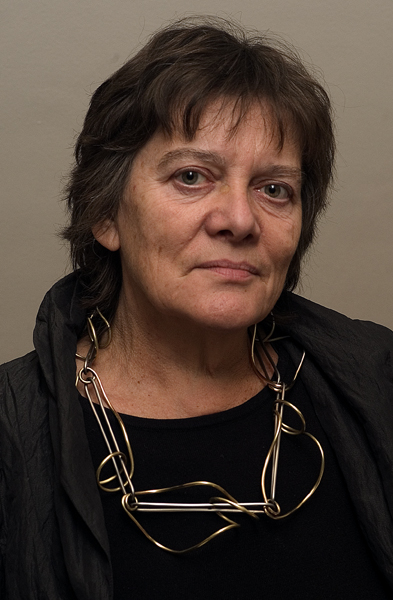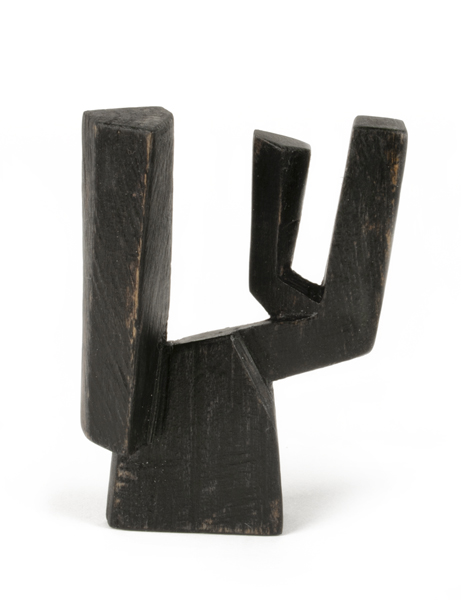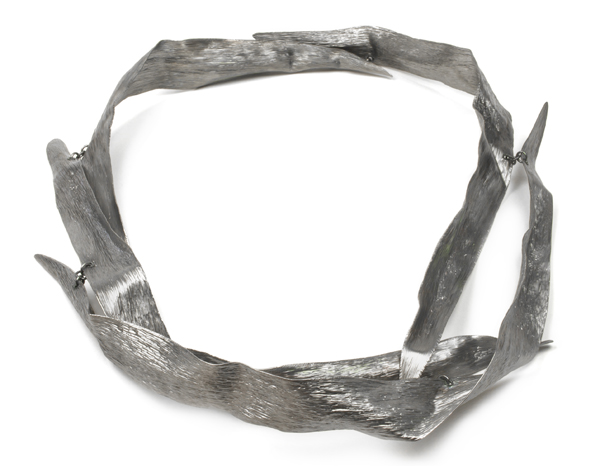
Susan Cummins: Marie- Jose, what led you to create a four-storey high jewelry gallery in a smallish town in the middle of the Netherlands?
Marie Jose Van Den Hout: Well, I started my gallery in Nijmegen. This is my second move and my third building. The Town Council of Nijmegen wanted to create a cultural destination for this building and asked me if I was interested. I would never be able to get a building like this anywhere else in Holland. Actually, the original intent for the building was for it to be demolished and sold to Holiday Inn to build a hotel, but the Town Council decided otherwise. When I bought the space it was a mere skeleton. Bert Dirrix, the architect I hired to shape the gallery, designed some museums. We chose simple materials – concrete, glass and steel – and kept the original walls. Traces of its former life as a grain warehouse still remain in the building today. Above all, I wanted to give the jewelry room to breathe, in the same way that any fine art gallery would display their works of art. With Marzee, my original intention was to display jewelry alongside the different disciplines of art and design. But I found that people tend to take you more seriously if you specialize. Now that I have made a name for myself, I collaborate with the largest fine arts gallery in Holland, Nouvelles Images. We exchange exhibitions – I receive work from, say, a sculptor and they receive work by a jeweler – so that in the end I am able to achieve the diversity I always aspired to represent.

Marie Jose Van Den Hout: The gallery is comprised of four floors. The basement houses a kitchen, which we use for special occasions and openings. The first floor contains both the glass house exhibition space and the collection that is for sale. Every month or so we host concerts for contemporary classical music, which are also performed on this floor. The second floor is primarily used for exhibition purposes. Finally, the third floor houses my own personal collection. A steel staircase that zigzags between the floors connects the different levels. The windows look out onto a fantastic view of the river with ships coming and going from Rotterdam. Marzee is a gallery with a view, both literally and figuratively. Spatially, the size is very human and conveys, I feel, a poetically quiet atmosphere. In my gallery, I feel I have room to breathe.
Your collection on the third floor is substantial and well known. Please describe your commitment to it and what your intentions are for it in the future.
Marie Jose Van Den Hout: I have been adding to my collection for over 25 years. It represents a visual history of the gallery because I only collect work from my own exhibitions. If somebody who I have not exhibited were to offer me pieces for the collection, I would decline. This is my commitment to the collection; it is the history of my gallery. Regarding my future intentions, Marzee could eventually be a privately owned museum. Even now it could be considered a museum; it has a museum shop, exhibition spaces and a museum collection on permanent display, which is not different to a lot of museums.

Marie Jose Van Den Hout: No, I do not use the same criteria. The pieces I choose for my collection are timeless. I collect important, iconic works. Wearability is not a consideration when I buy pieces for my collection. Maybe it could be said that the pieces that are for sale are more wearable, but wearable is such a relative term! Generally, for my collection, I prefer big, sculptural work with conceptual depth and consideration. The work represented is not acquired solely based on its aesthetic, although I do appreciate good design. I think of the pieces in my collection as little compositions; necklaces are painterly and rings are small sculptures. The way I perceive fine art and the way I perceive jewelry are one and the same.
Your yearly graduate show is coming up this month. What do you do to prepare for this show?
Marie Jose Van Den Hout: I travel to as many colleges and academies and graduation shows as I can and from these trips I select work. We also contact the various international schools and request images of work from them. Following that, we select work and invite graduates to participate. It is a lot of differentiating, looking at visual information and making inferences. Selecting work represented by images alone is especially difficult because so much of the tactility and physical presence is lost, but we always manage to do it – and we sometimes make mistakes.
How has the contemporary jewelry scene changed over the decades you have been in business? What needs to happen to make it thrive?

I wish I knew the exact formula for how to make the contemporary jewelry scene thrive. I do think there should be more museums with a jewelry collection that is visible and as equally regarded as other fine art forms. Also there should be more books and critical discussion about jewelry. With that said I think it is time to stop wondering, ‘What is jewelry?’ Questions on the identity of jewelry often stifle the equally important discussion of what is good, bad, commercial and so on and so forth. Why not take the identity of jewelry for granted in the same way that fine art and literature’s identities are not questioned? For example, when we look at a painting we do not question, what makes this a painting? If we can move beyond this question I think we will be able to open the doors to a deeper and more expressive discussion about the conceptual and visual content of the work.
And finally, one last question that I have forgotten to ask in the past. How did the gallery come by its name?
Marzee is short for Marie-José. My siblings found it hard to pronounce my name and when you say it fast in Dutch it sounds like Marzee. So since I was a teenager my siblings and my school friends called me Marzee. Then there is this nice word play that Mar means sea in Latin and Zee is the Dutch word for sea.

Antje Bräuer: Großenhain is a little town, not far away from the village where I spent my childhood and where I live now. The name of this village is Hohenleipisch. It is situated between Berlin and Dresden. So Großenhain is only the place where I was born, I have no special connection to it other than that. Hohenleipisch is situated on one side of a wide valley with a little river. My house is not in the middle of the village, but out among the fields and meadows and trees. This place is absolutely connected with me and with the idea of making jewelry. Now after many years I understand this.
Please tell us the story about how you decided to become a jeweler.
Antje Bräuer: Hohenleipisch is a traditional place for potters. You can find clay of high quality here. In former times all vessels and bowls are made from clay and the old shards are scattered all over the fields. My sister (she is eight years older than me) encouraged me to collect these fragments. She wanted to become a potter, which she eventually did. Later I was much more impressed by the stones I found. I wanted to make something with these stones but nobody in my surroundings could help me. Then I realized that if I could learn goldsmithing, I could make it myself. So I went from stone to metal and then to all other materials – I excluded nothing. I am convinced of the special nature of every material and try to use it for the right reasons.

Antje Bräuer: I am very glad I had the opportunity to study in Halle with Dorothea Prühl. The first time I met Dorothea I was seventeen years old. Without knowing it I was very lucky because it was a good fit. That is how I feel. I spent many years in Halle where I could ‘play’ and learn at the same time. It was like in a new family. I often think about what I have learned about jewelry and I must say I can’t explain it exactly. There are no words. What I learned from Dorothea was to create what you want, be convinced about your idea and give it all the passion you have. The most important lessons for me were not only for making jewelry, but also for life: What don’t I really need? What is the essence? And never forget, that you want to make serious wearable jewelry. Good design quality is in both the artistic idea and in the process of making it.
Your brooches have the feeling of being newly born forms with suggestions of numerous possibilities. How you arrive at these shapes?
Antje Bräuer: I feel like a sculptor and I am an observer. First I choose my material, although sometimes I make mistakes and have to change. The idea or the picture in my head is sometimes too big to give it life. So I try it again. My pieces should grow like nature around me. I work with accidents and surprises and try to accept them. I go from outside to inside of each piece. I could compare it with peeling a fruit. I really like to speak about my work, but sometimes I have the feeling that the thoughts are too complex to express them in words (like the impossibility of writing a love letter). So it is good to have at last a piece of jewelry, a little sculpture in the dimension of my hands. Yes, you are right, they suggest numerous possibilities! That includes my own understanding and feelings as well as the thoughts of others based on their own impressions and experiences. Everybody should have the freedom to see it with his or her own eyes. That is why I dislike telling stories about the work – nevertheless they exist.

Antje Braeuer: Yes, the tree in front of my house! It is a cherry tree, one of many around the village. This is a beautiful place in the spring. Mostly I look on this tree in the evening, when the colors are gone, nature is grey and the shadows are important. Suddenly I saw the form of a woman and since that evening I always see that woman. I asked myself why? What is the special shape of this tree? The brooch Woman is an attempt to find a solution. It is like looking in the sky, seeing the clouds . . .
Can you recommend a recent book you have enjoyed? How about one on jewelry?
Antje Bräuer: In the last years I had not such a lot of time to read, so I can’t give an actual recommendation. I am fascinated again and again by the books of Thomas Bernhard. Suggesting a book about jewelry is difficult! The wide range of varieties confuses me sometimes. So I prefer books about old ornaments. I like the structure in them.
What do you do when you are not making jewelry?
Antje Bräuer: I like gardening. And I am searching for new ideas to build and design the house. I also work with ceramics as well as metals. Mostly I do really normal things that are probably typical for living in the countryside . . .





